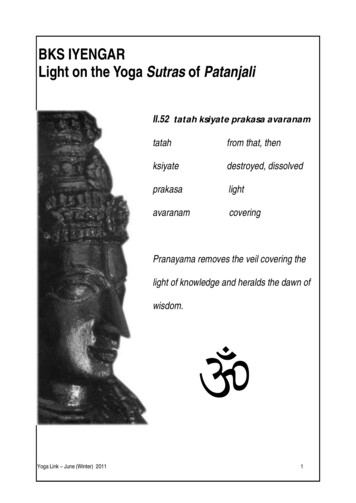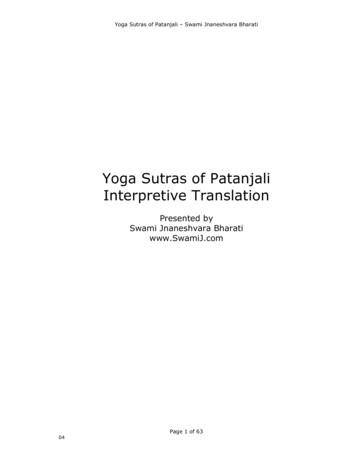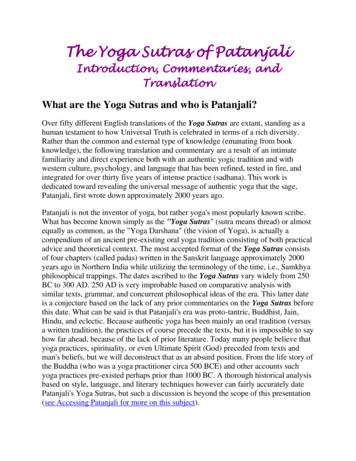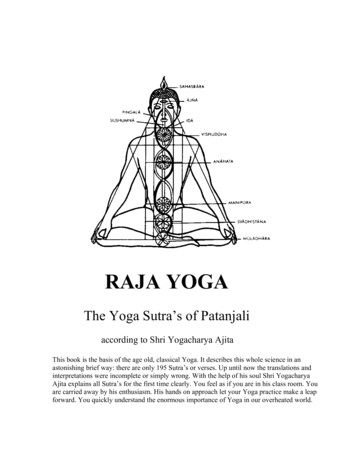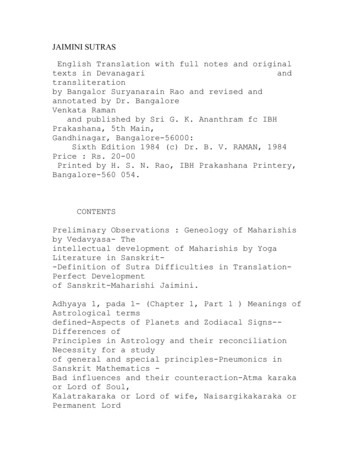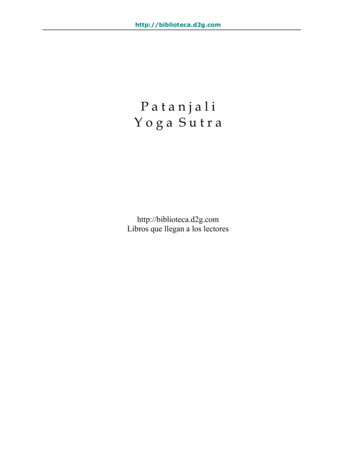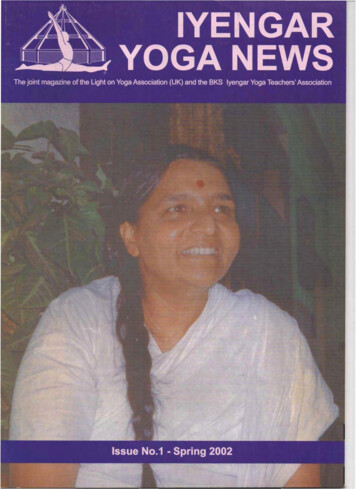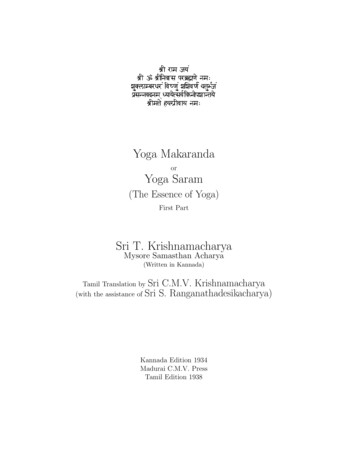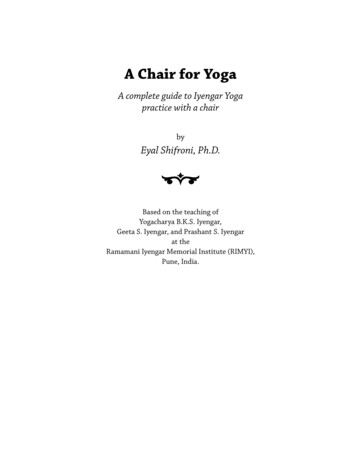
Transcription
Hççlç¡çuç³ççíiçmçÓ çççÆCçPatanjali Yoga SutrasSanskrit text with Transliteration, Translation & CommentaryCommentary BySwami Vivekananda
ऩातञ्जरमोगसत्रू ाणिPATANJALI YOGA SUTRASSanskrit text with Translation and CommentaryBySwami Vivekananda
Patanjali Yoga SutrasContentsINTRODUCTION . 3CHAPTER I - SAMADHI PADA. 9CHAPTER II - SADHANA PADA . 54CHAPTER III – VIBHOOTI PADA. 98CHAPTER IV – KAIVALYA PADA . 1232
Patanjali Yoga SutrasINTRODUCTIONBEFORE going into the Yoga Aphorisms I will try to discussone great question, upon which the whole theory of religionrests, for the Yogis. It seems the consensus of opinion of thegreat minds of the world, and it has been nearly demonstratedby researchers into physical nature, that we are the outcomeand manifestation of an absolute condition, back of ourpresent relative condition, and are going forward, to returnagain to that absolute. This being granted, the question is,which is better, the absolute or this state? There are notwanting people who think that this manifested state is thehighest state of man. Thinkers of great calibre are of theopinion that we are manifested specimens of undifferentiatedbeing, and this differentiated state is higher than the absolute.Because in the absolute there cannot be any quality theyimagine that it must be insensate, dull, and lifeless, that onlythis life can be enjoyed, and therefore we must cling to it. Firstof all we want to inquire into other solutions of life. There wasan old solution that man after death remained the same, thatall his good sides, minus his evil sides, remained forever.Logically stated this means that man’s goal is the world; thisworld carried a stage higher, and with elimination of its evilsis the state they call heaven. This theory, on the face of it, isabsurd and puerile, because it cannot be. There cannot begood without evil, or evil without good. To live in a worldwhere all is good and no evil is what Sanskrit logicians call a“dream in the air.” Another theory in modern times has beenpresented by several schools, that man’s destiny is to go onalways improving, always struggling towards, and never3
Patanjali Yoga Sutrasreaching, the goal. This statement, though, apparently, verynice, is also absurd, because there is no such thing as motionin a straight line. Every motion is in a circle. If you could takeup a stone, and project it into space, and then live longenough, that stone would come back exactly to your hand. Astraight line, infinitely projected, must end in a circle.Therefore, this idea that the destiny of man is progression everforward and forward, and never stopping, is absurd. Althoughextraneous to the subject, I may remark that this idea explainsthe ethical theory that you must not hate, and must love,because, just as in the case of electricity, or any other force,the modern theory is that the power leaves the dynamo andcompletes the circle back to the dynamo. So with all forces innature; they must come back to the source. Therefore do nothate anybody, because that force, that hatred, which comesout from you, must, in the long run, come back to you. If youlove, that love will come back to you, completing the circuit.It is as certain as can be, that every bit of hatred that goes outof the heart of man comes back to him full force; nothing canstop it, and every impulse of love comes back to him. Onother and practical grounds we see that the theory of eternalprogression is untenable, for destruction is the goal ofeverything earthly. All our struggles and hopes and fears andjoys, what will they lead to? We will all end in death. Nothingis so certain as this. Where, then, is this motion in a straightline? This infinite progression? It is only going out to adistance, and again coming back to the centre from which itstarted. See how, from nebulæ, the sun, moon, and stars, areproduced; then they dissolve, and go back to nebulæ. Thesame is being done everywhere. The plant takes material fromthe earth, dissolves, and gives it back. Every form in this4
Patanjali Yoga Sutrasworld is taken out of corresponding atoms and goes back tothose atoms.It cannot be that the same law acts differently in differentplaces. Law is uniform. Nothing is more certain than that. Ifthis is the law of nature, so it is with thought; it will dissolveand come back to its origin; whether we will it or not we shallhave to return to the origin, which is called God or Absolute.We all came from God, and we are all bound to go to God, callthat God by any name you like; call Him God, or Absolute orNature, or by any hundred names you like, the fact remainsthe same. “From whom all this universe comes out, in whomall that is born lives, and to whom all returns.” This is one factthat is certain. Nature works on the same plan; what is beingworked out in one sphere is being worked out in millions ofspheres. What you see with the planets, the same will it bewith this earth, with men and with the stars. The huge wave isa mighty compound of small waves, it may be of millions; thelife of the whole world is a compound of millions of littlelives, and the death of the whole world is the compound of thedeaths of those millions of little beings.Now the question arises, is going back to God the higher state,or is it not? The philosophers of the Yoga school answeremphatically that it is. They say that man’s present state is adegeneration; that there is no one religion on the face of theearth which says that man is an improvement. The idea idea asthat his beginning is perfect and pure, that he degeneratesuntil he cannot degenerate further, and that there must come atime when he shoots upward again to complete the circle; thecircle must be there. However low he goes, he must ultimately5
Patanjali Yoga Sutrastake the upward bend again, and go back to the originalsource, which is God. Man comes from God in thebeginning, in the middle he becomes man, and in the end hegoes back to God. This is the method of putting it in theDualistic form. In the Monistic form you say that man is God,and goes back to Him again. If our present state is the higherone, then why is there so much horror and misery, and why isthere an end to it? If this is the higher state, why does it end?That which corrupts and degenerates cannot be the higheststate. Why should it be so diabolical, so unsatisfying? It isonly excusable, inasmuch as, through it, we are taking ahigher groove; we have to pass through it in order to becomeregenerate again. Put a seed into the ground and itdisintegrates, dissolves after a time, and out of that dissolutioncomes the splendid tree. Every seed must degenerate tobecome the stately tree. So it follows that the sooner we getout of this state we call “man” the better for us. Is it bycommtting suicide that we get out of this state? Not at all.That will be making it all the worse. Torturing ourselves, orcondemning the world, is not the way to get out. We have topass through the “Slough of Despond,” and the sooner we arethrough the better. But it must always be remembered that thisis not the highest state.The really difficult part to understand is that this state, theAbsolute, which has been called the highest, is not, as somefear, that of the zoophite, or of the stone. That would be adangerous thing to think. According to these thinkers thereare only two states of existence, one of the stone, and the otherof thought. What right have they to limit existence to thesetwo. Is there not something infinitely superior to thought? The6
Patanjali Yoga Sutrasvibrations of light, when they are very low, we do not see;when they become a little more intense they become light tous; when they become still more intense we do not see them; itis dark to us. Is the darkness in the end the same as in thebeginning? Certainly not; it is the difference of the two poles.Is the thoughtlessness of the stone the same as thethoughtlessness of God? Certainly not. God does not think;He does not reason; why should He? Is anything unknown toHim, that He should reason? The stone cannot reason; Goddoes not. Such is the difference. These philosophers think it isawful if we go beyond thought; they find nothing beyondthought.There are much higher states of existence beyond reasoning.It is really beyond the intellect that the first stage of religiouslife is to be found. When you step beyond thought andintellect and all reasoning, then you have made the first steptowards God; and that is the beginning of life. This that iscommonly called life is but an embryo state.The next question will be, what proof is there that this statebeyond thought and reasoning is the highest state? In the firstplace, all the great men of the world, much greater than thosethat only talk, men who moved the world, men who neverthought of any selfish ends whatever, have declared that thisis but a little stage on the way, that the Infinite is beyond. Inthe second place, they not only say so, but lay it open toeveryone, they leave their methods, and all can follow in theirsteps. In the third place, there is no other way left. There is noother explanation. Taking for granted that there is no higherstate, why are we going through this circle all the time; what7
Patanjali Yoga Sutrasreason can explain the world? The sensible will be the limit toour knowledge if we cannot go farther, if we must not ask foranything more. This is what is called agnosticism. But whatreason is there to believe in the testimony of the senses? Iwould call that man a true agnostic who would stand still inthe street and die. If reason is all in all it leaves us no place tostand on this side of nihilism. If a man is agnostic ofeverything but money, fame and name, he is only a fraud.Kant has proved beyond all doubt that we cannot penetratebeyond the tremendous dead wall called reason. But that is thevery first idea upon which all Indian thought takes its stand,and dares to seek, and succeeds in finding something higherthan reason, where alone the explanation of the present state isto be found. This is the value of the study of something thatwill take us beyond the world. “Thou art our Father, and wilttake us to the other shore of this ocean of ignorance;” that isthe science of religion; nothing else can be.8
Patanjali Yoga SutrasCHAPTER I - SAMADHI PADACONCENTRATION: ITS SPIRITUAL USES॥ प्रथभ् सभाणधऩाद् ॥् १॥ु1. अथ मोगानशासनभ॥atha yoganushasanamNow concentration is explained.2. �ोध् ॥ २॥yogashchittavrittinirodhahYoga is restraining the mind-stuff (Chitta) fromtaking various forms (Vrttis)A good deal of explanation is necessary here. We have tounderstand what Chitta is, and what are these Vrttis. I havethis eye. Eyes do not see. Take away the brain centre which isin the head, the eyes will still be there, the retinæ complete,and also the picture, and yet the eyes will not see. So the eyesare only a secondary instrument, not the organ of vision. Theorgan of vision is in the nerve centre of the brain. The twoeyes will not be sufficient alone. Sometimes a man is asleepwith his eyes open. The light is there and the picture is there,but a third thing is necessary; mind must be joined to theorgan. The eye is the external instrument, we need also thebrain centre and the agency of the mind. Carriages roll down a9
Patanjali Yoga Sutrasstreet and you do not hear them. Why? Because your mind hasnot attached itself to the organ of hearing. First there is theinstrument, then there is the organ, and third, the mindattachment to these two. The mind takes the impressionfarther in, and presents it to the determinativefaculty—Buddhi—which reacts. Along with this reactionflashes the idea of egoism. Then this mixture of action andreaction is presented to the Purusa, the real Soul, whoperceives an object in this mixture. The organs (Indriyas),together with the mind (Manas), the determinative faculty(Buddhi) and egoism (Ahamkara), form the group called theAntahkarana (the internal instrument). They are but variousprocesses in the mind-stuff, called Chitta. The waves ofthought in the Chitta are called Vrtti (“the whirlpool” is theliteral translation). What is thought? Thought is a force, as isgravitation or repulsion. It is absorbed from the infinitestorehouse of force in nature; the instrument called Chittatakes hold of that force, and, when it passes out at the otherend it is called thought. This force is supplied to us throughfood, and out of that food the body obtains the power ofmotion, etc. Others, the finer forces, it throws out in what wecall thought. Naturally we see that the mind is notintelligent; yet it appears to be intelligent. Why? Because theintelligent soul is behind it. You are the only sentient being;mind is only the instrument through which you catch theexternal world. Take this book; as a book it does not existoutside, what exists outside is unknown and unknowable. It isthe suggestion that gives a blow to the mind, and the mindgives out the reaction. If a stone is thrown into the water thewater is thrown against it in the form of waves. The realuniverse is the occasion of the reaction of the mind. A book10
Patanjali Yoga Sutrasform, or an elephant form, or a man form, is not outside; allthat we know is our mental reaction from the outersuggestion. Matter is the “permanent possibility ofsensation,” said John Stuart Mill. It is only the suggestion thatis outside. Take an oyster for example. You know how pearlsare made. A grain of sand or something gets inside and beginsto irritate it, and the oyster throws a sort of enameling aroundthe sand, and this makes the pearl. This whole universe is ourown enamel, so to say, and the real un
Patanjali Yoga Sutras 4 reaching, the goal. This statement, though, apparently, very nice, is also absurd, because there is no such thing as motion in a straight line. Every motion is in a circle. If you could take up a stone, and project it into space, and then live long enough, that stone would come back exactly to File Size: 1MBPage Count: 143
